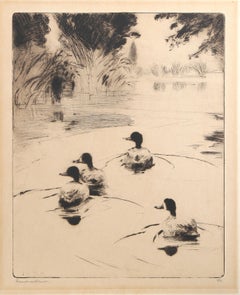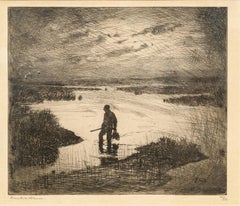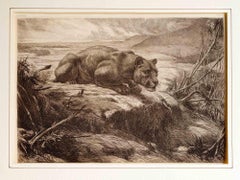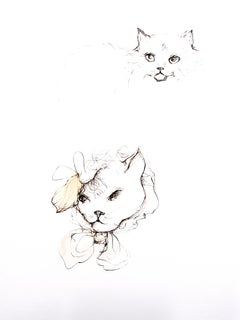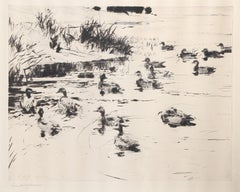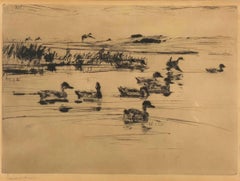Frank Weston Benson Prints and Multiples
to
1
1
Overall Width
to
Overall Height
to
2
4
1,164
884
844
811
2
1
1
1
2
2
1
1
1
1
1
1
1
1
2
1
1
2
Artist: Frank Weston Benson
Ducks at Play, Signed Modern Etching Mounted to Board by Frank Weston Benson
By Frank Weston Benson
Located in Long Island City, NY
Ducks at Play
Frank Weston Benson, American (1862–1951)
Date: 1940
Etching mounted to board, signed and dated in pencil
Image Size: 10 x 8 inches
Size: 12 x 10 in. (30.48 x 25.4 cm)
Category
1940s Modern Frank Weston Benson Prints and Multiples
Materials
Etching
Frank Weston Benson Original Etching, Early 20th Century
By Frank Weston Benson
Located in New York, NY
Frank Weston Benson (American, 1862-1951)
Untitled, 20th Century
Etching
Sight: 10 1/3 x 12 1/8 in.
Framed: 16 3/4 x 19 x 1/2 in.
Signed lower left
Numb...
Category
20th Century Modern Frank Weston Benson Prints and Multiples
Materials
Etching
Related Items
Lioness i- Etching by Evert Louis van Muyden - 1900
By Evert Louis van Muyden
Located in Roma, IT
Lioness is a modern artwork realized by Evert Louis van Muyden (Albano, Lazio 1853 - 1922 Orsay) in 1900 .
Black and white etching.
Signature and date on plate.
Includes passe-pa...
Category
Early 1900s Modern Frank Weston Benson Prints and Multiples
Materials
Etching
$538
H 7.09 in W 10.24 in D 0.04 in
Leonor Fini - Cats - Original Etching
By Leonor Fini
Located in Collonge Bellerive, Geneve, CH
Leonor Fini - Cats - Original Engraving
Mme.Helvetius' Cats
Original etching created in 1985, Printed Signature (LF).
Conditions: excellent
Edition: 100
Support: Arches paper.
Dimensions: Paper dimensions: 44 x 28 cm
Editions: Moret, Paris.
Leonor Fini is considered one of the most important women artists of the mid-twentieth century, along with Leonora Carrington, Frida Kahlo, Meret Oppenheim, Remedios Varo, and Dorothea Tanning – most of whom Fini knew well. Her career, which spanned some six decades, included painting, graphic design, book illustration, product design (the renowned torso-shaped perfume bottle for Schiaparelli’s Shocking), and set and costume design for theatre, ballet, opera, and film. In this compellingly readable, exhaustively researched account, author Peter Webb brings Fini’s provocative art and unconventional personal life, as well as the vibrant avant-garde world in which she revolved, vividly in life.
Born in Buenos Aires in 1907 (August 30 – January 18, 1996, Paris) to Italian and Argentine parents, Leonor grew up in Trieste, Italy, raised by her strong-willed, independent mother, Malvina. She was a virtually self-taught artist, learing anatomy directly from studying cadavers in the local morgue and absorbing composition and technique from the Old Masters through books and visits to museums.
Fini’s fledging attempts at painting in Trieste let her to Milan, where she participated in her first group exhibition in 1929, and then to Paris in 1931.
Her vivacious personality and flamboyant attire instantly garnered her a spotlight in the Parisian art world and she soon developed close relationships with the leading surrealist writers and painters, including Paul Eluard, Salvador Dali, Man Ray, and Max Ernst, who became her lover for a time. The only surrealist she could not abide because of his misogyny was André Breton. Although she repeatedly exhibited with them, she never considered herself a surrealist. The American dealer Julien Levy,
very much impressed by Fini’s painting and smitten by her eccentric charms, invited her to New York in 1936, where she took part in a joint gallery exhibition with Max Ernst and met many American surrealists, including Joseph Cornell and Pavel Tchelitchew. Her work was included in MoMA’s pivotal Fantastic Art, Dada and Surrealism exhibition, along with De Chirico, Dali, Ernst, and Yves Tanguy.
In 1939 in Paris she curated an exhibition of surrealist furniture for her childhood friend Leo Castelli for the opening of his first gallery.
Introductions to her exhibition catalogues were written by De Chirico, Ernst, and Jean Cocteau.
A predominant theme of Fini’s art is the complex relationship between the sexes, primarily the interplay between the dominant female and the passive, androgynous male. In many of her most powerful works, the female takes the form of a sphinx, often with the face of the artist. Fini was also an accomplished portraitist; among her subjects were Stanislao Lepri...
Category
1980s Modern Frank Weston Benson Prints and Multiples
Materials
Etching
Les bleus de Barcelone
By Pablo Picasso
Located in OPOLE, PL
This work will be exhibited at Art on Paper NYC, September 4–7, 2025.
–-
Technique: Aquatint and etching
Paper: Gourbeyre wove paper with watermark “Au Vent d’Arles”
Edition: 73/75...
Category
20th Century Modern Frank Weston Benson Prints and Multiples
Materials
Etching
Engraving #1 by Ernst Fuchs: KABBALAH (SEFER YETSIRA and 32 PATHS OF WISDOM)
By Ernst Fuchs
Located in Cliffside Park, NJ
Original engraving #7 by Ernst FUCHS from Kabbalah (THIRTY-TWO PATHS OF WISDOM by SEFER YETZIRA), 1978
Etching signed and numbered 16/30 E.A.
Page size - 30 ...
Category
1970s Modern Frank Weston Benson Prints and Multiples
Materials
Paper, Etching
Erotic Scene VIII - Illustration
By Emil Sartori
Located in Roma, IT
Original title: Die Tanzerin
This original etching and aquatint, blue ink on ivory colored paper is hand-signed in pencil on lower-left. Edition of 530 prints. Including a poem by Amadée de la Houlette. Representing a vintage erotic scene...
Category
Early 1900s Modern Frank Weston Benson Prints and Multiples
Materials
Etching, Aquatint
$251 Sale Price
30% Off
H 13.55 in W 11.82 in D 0.04 in
Latvian Modernist 'The Sky Hides All It's Birds' Intaglio Etching Embossing
By Adja Yunkers
Located in Surfside, FL
Printed on Dark Paper a magnificent piece. this is an etching with embossing
on black wove, J Barcham Green paper
Publisher Styria Studio, chopmark lower left
Adja Yunkers
b. 1900...
Category
1970s Modern Frank Weston Benson Prints and Multiples
Materials
Etching
$850
H 41.88 in W 30 in
Robert Henry Lewis, Modernist etching of Sofie the sleeping cat
Located in Harkstead, GB
Robert Henry Lewis (mid 20th Century)
"Sofie: : A sleeping cat
Signed, numbered 4/5 and dated "(19)64" beneath in image in pencil
Titled, "Sofie"
Etching
5.5 x 6.5 inches (image)
14....
Category
Mid-20th Century Modern Frank Weston Benson Prints and Multiples
Materials
Paper, Etching
$219 Sale Price
20% Off
H 5.5 in W 6.5 in D 1 in
The Analysis of the Hunting Field - Etching by Henry Alken- 1846
By Henry Alken
Located in Roma, IT
Etching and aquatint realized by Henry Alken in 1846. Plate from "The Analysis of the Hunting Field".
Very good condition.
Henry Alken (1765-1851) was en english painter and engrav...
Category
Mid-19th Century Modern Frank Weston Benson Prints and Multiples
Materials
Etching
$215 Sale Price
25% Off
H 4.53 in W 7.6 in D 0.04 in
Animal Kingdom (Magnificent Jungle Cats)
By Louise Nevelson
Located in Fairlawn, OH
Animal Kingdom (Magnificent Jungle Cats)
Etching, 1953-1955
Signed and titled in pencil by the artist (see photos)
Annotated: "First Proof" (see photo)
Estate stamp verso (see photo)...
Category
1950s American Modern Frank Weston Benson Prints and Multiples
Materials
Etching
Leonor Fini - Cats Trio - Original Hand-Signed Etching
By Leonor Fini
Located in Collonge Bellerive, Geneve, CH
Leonor Fini - Cats - Original Engraving
Mme.Helvetius' Cats
Original etching created in 1985
Hand-Signed
Conditions: excellent
Edition: 71/100
Support: Arches paper.
Dimensions: Pape...
Category
1980s Modern Frank Weston Benson Prints and Multiples
Materials
Etching
$1,436
H 17.33 in W 11.03 in D 0.04 in
Returning to the Stable.
By Edmund Blampied
Located in Storrs, CT
Returning to the Stable. 1920. Drypoint. Appleby 64. 8 3/4 x 12 1/4 (sheet 11 7/16 x 16 1/8). Edition 100. A rich impression printed on cream laid paper wi...
Category
1920s Modern Frank Weston Benson Prints and Multiples
Materials
Drypoint, Etching
Lumbermen.
By Edmund Blampied
Located in Storrs, CT
Lumbermen. 1923. Etching. Appleby 91. 9 x 12 (sheet 12 3/8 x 18 1/8). Edition 100. A cleanly-wiped impression printed on off-white 'FG Head & Co' laid paper with full margins. Signed...
Category
1920s Modern Frank Weston Benson Prints and Multiples
Materials
Drypoint, Etching
Previously Available Items
Ducks on Lake, Signed Modern Etching by Frank Weston Benson
By Frank Weston Benson
Located in Long Island City, NY
Ducks on Lake
Frank Weston Benson, American (1862–1951)
Date: 1923
Etching on thin wove paper, signed in pencil and dated in the plate
Image Size: 11 x 14 inches
Size: 14 x 16.5 in. ...
Category
1920s Modern Frank Weston Benson Prints and Multiples
Materials
Etching
Teal
By Frank Weston Benson
Located in Missouri, MO
Frank Weston Benson (1862-1951)
"Teal" 1925 (Paff 243)
Etching
Ed. 150
Signed Lower Left
Image Size: approx 8 x 10 inches
Framed Size: approx 14.5 x 16 inches
Born in Salem, Massac...
Category
1920s American Realist Frank Weston Benson Prints and Multiples
Materials
Etching
The Alarm
By Frank Weston Benson
Located in Missouri, MO
Frank Weston Benson (1862-1951)
"The Alarm" 1917
Etching
Ed. 80
Signed Lower Right
Image Size: approx 8 x 10 inches
Framed Size: approx 14.5 x 16 inches
Born in Salem, Massachusett...
Category
1910s Realist Frank Weston Benson Prints and Multiples
Materials
Etching
Two Canoes.
By Frank Weston Benson
Located in Storrs, CT
Two Canoes 1927. Etching. Paff catalog 266 state iii. 5 7/8 x 7 3/4 (sheet 9 x 11 1/4). Edition 150. An extremely rich impression with plate tone, printed on cream laid paper on the full sheet with deckle edges. Provenance: the artist's family. Signed in pencil. Housed in a 16 x 20-inch archival mat, suitable for framing.
Frank W. Benson was born and raised in Salem, Massachusetts. He spent a great deal of time in the salt marshes that surrounded this costal town studying, as well as hunting, various waterfowl. He painted his first oil of shore birds at the age of twelve. At nineteen he attended the School of Drawing and Painting of the Museum of Fine Arts, Boston. While attending the school he produced his first etching, "Salem Harbor." In 1883 he traveled to Paris to study at the Academie Julie and for the next thirty years devoted his artistic talent to painting and watercolor.
In 1912 at the age of fifty he again began to produce prints. At first, these prints were portraits, then of waterfowl and nature oriented subjects, totaling over 355 various prints before his death in 1951. Today, Benson is considered the founder of the school of American sporting art...
Category
1920s American Modern Frank Weston Benson Prints and Multiples
Materials
Etching, Drypoint
On the Kedgwick
By Frank Weston Benson
Located in Storrs, CT
On the Kedgwick 1923. Etching. Paff 222. 7 3/4 x 11 3/4 (sheet 11 1/2 x 15 9/16). Edition 150. Illustrated: Fine Prints of the Year, 1923. A rich impression in excellent condition, printed on cream laid paper on the full sheet with deckle edges. Signed in pencil. Housed in a 16 x 20- inch archival mat, suitable for your choice of frame.
In the late summer of 1894, a friend invited Benson to go to New Brunswick, Canada, to fish for salmon. The artist discovered he loved the sport as well as camping out in the wilderness and thereafter made annual trips to Canada for almost 40 years. The Kedgwick River in New Brunswick was his favorite river for salmon fishing.
Frank W. Benson was born and raised in Salem, Massachusetts. He sepnt a great deal of time in the salt marshes that surrounded this costal town studying, as well as hunting, various waterfowl. He painted his first oil of shore birds at the age of twelve. At nineteen he attended the School of Drawing and Painting of the Museum of Fine Arts, Boston. While attending the school he produced his first etching, "Salem Harbor." In 1883 he traveled to Paris to study at the Academie Julie and for the next thirty years devoted his artistic talent to painting and watercolor.
In 1912 at the age of fifty he again began to produce prints. At first, these prints were portraits, then of waterfowl and nature oriented subjects, totaling over 355 various prints before his death in 1951. Today, Benson is considered the founder of the school of American sporting art...
Category
1920s American Modern Frank Weston Benson Prints and Multiples
Materials
Etching
Two Canoes
By Frank Weston Benson
Located in Storrs, CT
Two Canoes 1927. Etching. Paff 266.i/iii 5 7/8 x 7 3/4 (sheet 9 5/8 x 10 3/4). Trial proof A-5, prior to the edition 150. An extremely rich impression of a fascinating window into the way the artist developed the image. Housed in a 16 x 20-inch archival mat, suitable for your choice of frame.
Frank W. Benson was born and raised in Salem, Massachusetts. He sepnt a great deal of time in the salt marshes that surrounded this costal town studying, as well as hunting, various waterfowl. He painted his first oil of shore birds at the age of twelve. At nineteen he attended the School of Drawing and Painting of the Museum of Fine Arts, Boston. While attending the school he produced his first etching, "Salem Harbor." In 1883 he traveled to Paris to study at the Academie Julie and for the next thirty years devoted his artistic talent to painting and watercolor.
In 1912 at the age of fifty he again began to produce prints. At first, these prints were portraits, then of waterfowl and nature oriented subjects, totaling over 355 various prints before his death in 1951. Today, Benson is considered the founder of the school of American sporting art...
Category
1920s American Modern Frank Weston Benson Prints and Multiples
Materials
Etching, Drypoint
November Moon.
By Frank Weston Benson
Located in New York, NY
Signed in pencil.
Etching and aquatint, 1931.
Edition 150.
Image size 9 13/16 x 8" (25.1 x 20.4 cm).
Paff #316.
Very good condition.
Category
1930s American Impressionist Frank Weston Benson Prints and Multiples
Materials
Etching
The Moose Caller.
By Frank Weston Benson
Located in New York, NY
Signed and numbered "10" in pencil. A very nice and rich impression.
Etching, 1915.
Edition 50.
Image size 7 3/4 x 11 7/8" (19.7 x 30.2 cm).
Good condi...
Category
1910s American Impressionist Frank Weston Benson Prints and Multiples
Materials
Etching
Geese.
By Frank Weston Benson
Located in Storrs, CT
Geese. 1917. Drypoint. Paff 124. 10 x 15 1/2 (sheet 13 3/16 x 17 3/4). Trial proof, before the edition of 79 proofs in 4 states. Illustrated: Salaman, Modern Masters of Etching: Fran...
Category
1910s American Modern Frank Weston Benson Prints and Multiples
Materials
Drypoint
Mallards
By Frank Weston Benson
Located in Storrs, CT
Mallards at Evening 1927. Drypoint. Paff 271. 13 7/8 x 11 7/8 (sheet 15 7/8 C 13 4/5). Edition 112. An extremely rich impression with drypoint burr, printed on the full sheet of crea...
Category
1920s Modern Frank Weston Benson Prints and Multiples
Materials
Drypoint
Frank Weston Benson prints and multiples for sale on 1stDibs.
Find a wide variety of authentic Frank Weston Benson prints and multiples available for sale on 1stDibs. You can also browse by medium to find art by Frank Weston Benson in etching and more. Much of the original work by this artist or collective was created during the 20th century and is mostly associated with the modern style. Not every interior allows for large Frank Weston Benson prints and multiples, so small editions measuring 12 inches across are available. Customers who are interested in this artist might also find the work of John French Sloan, Charles Turzak, and Yasuo Kuniyoshi. Frank Weston Benson prints and multiples prices can differ depending upon medium, time period and other attributes. On 1stDibs, the price for these items starts at $2,250 and tops out at $8,000, while the average work can sell for $2,750.
